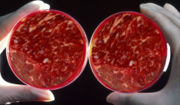Food/In-vitro meat
"Fifty years hence, we shall escape the absurdity of growing a whole chicken in order to eat the breast or wing, by growing these parts separately under a suitable medium."
In-vitro meat has already been created successfully [1], but there is still work to be done on making it efficient enough to do on a large scale and on getting the texture and taste right. Muscle grown in this way has never been exercised, so it has a wasted texture. However, researchers are confident they can overcome these challenges.
The inventor of the technique estimated that its price fell by a factor of 30,000 in a period of 18 months[2]
If this technique is perfected, it would be possible to grow millions of kilos of meat from cells taken from a single animal. This would require much less land, water and energy than raising livestock, and enable us to enjoy our steaks without animals dying or suffering. One study estimated that in-vitro meat would use 35-60% less energy than raising livestock, 80-95% less greenhouse gases and 98% less land. Precise control of the growth-medium would also allow us to create meat with a desirable nutritional profile (much like the controlled environment growing of plants described above). Along with aquaponics and sustainable aquaculture, this can take the demand off the oceans' limited fish stocks.
The same method could also be applied to creating leather, fur and other animal products.
